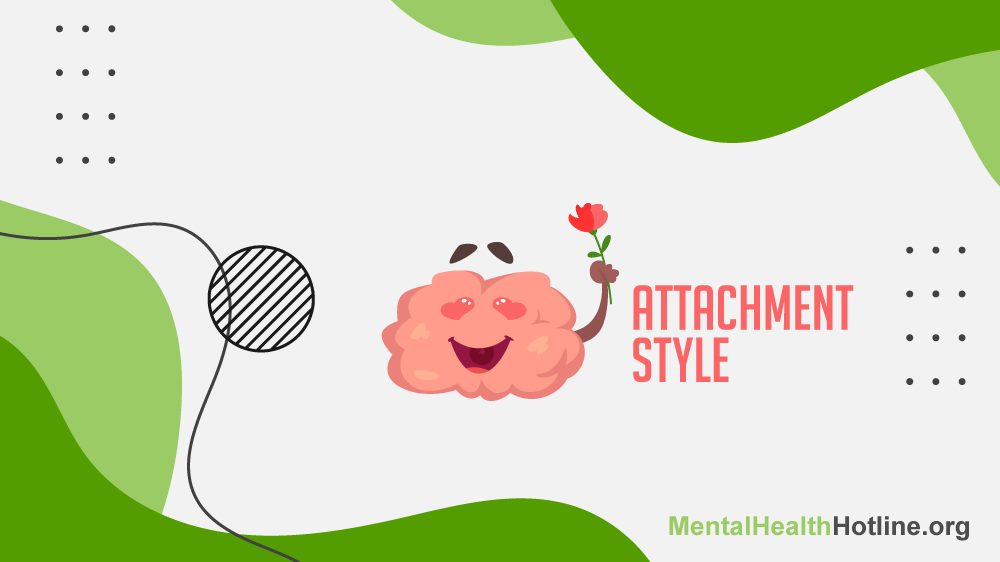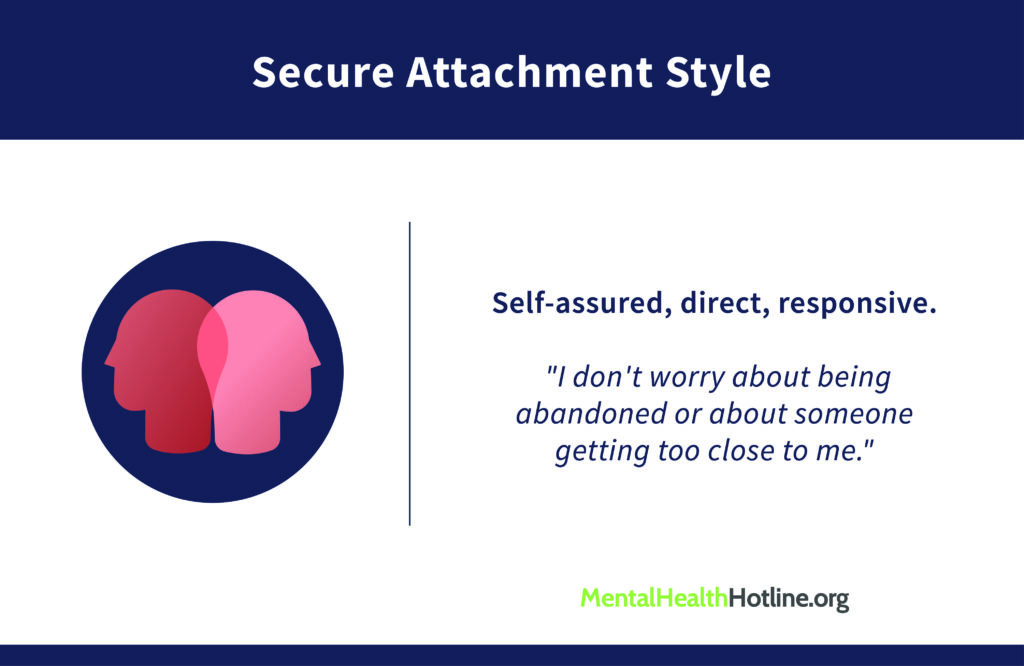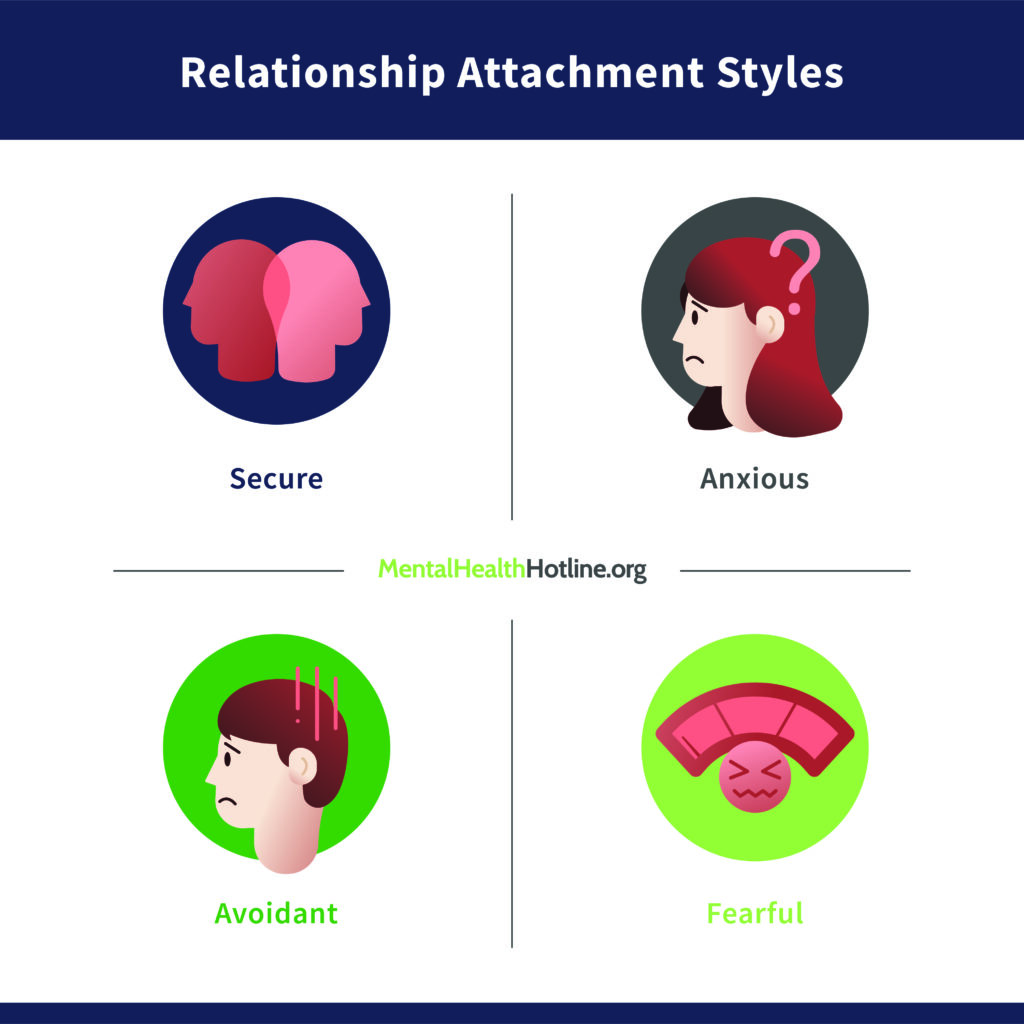
Relationships, whether friendly or romantic, tend to be quite revealing. A relationship can uncover gaps in your life you didn’t know existed or fill all the spaces you’ve always felt were empty. However, a relationship can also turn you from a happy, confident person into an insecure mess who worries about losing the person you love.
Such changes may be less jarring if you understand your relationship attachment style. An attachment style test can illuminate your behavior, uncover your needs and desires and prepare you for healthy and satisfying relationships.
If you’ve never taken an attachment style quiz, you may wonder, “What’s my attachment style, and why is it important?” Follow along as we explore the origins of attachment theory, its application to your current life and what to expect when taking an attachment style quiz to know how you form bonds with others.
What Is the Relationship Attachment Style Theory?
For a long time, psychologists and psychiatrists felt that humans formed attachments to fulfill their physical needs. They believed you only bond with people who give you what you need or want, whether it’s food, clothing or shelter.
However, in the late 1950s, a psychologist named John Bowlby proposed that human bonds have a more profound significance than mere physical fulfillment. Bowlby’s attachment theory suggests that we’re genetically set up to form close bonds with others depending on how responsive they are to our psychological, emotional and safety needs.
Harry Harlow’s famous surrogate mother experiment with infant rhesus monkeys tested Bowlby’s theory. During the experiment, Harlow separated baby monkeys from their birth mothers and placed them in a cage with two inanimate monkeys: one made of wire and wood and the other made from foam rubber and covered in soft terry cloth. In one version of the experiment, the wire monkey had a milk bottle, while the rubber one had nothing. In a different variation, the rubber monkey held the milk bottle while the wire monkey had nothing.
The baby monkeys in the first version of the experiment would go to the wire mother to drink milk but spent more time hugging and clinging to the rubber monkey. And when only the rubber monkey had food, the babies would spend more time with it than with the wire monkey.
This experiment showed that we don’t automatically get attached to someone who fulfills our physical needs. Instead, a feeling of safety and protection is crucial to forming close bonds.
Bowlby’s attachment theory also says the types of bonds you form with your parent, guardian or primary caregiver as a baby form the basis for your attachment style well into adulthood.
In the 1970s, psychologist Mary Ainsworth designed the Strange Situation Experiment to explore the effect of maternal attachment on the behavior of human children. The experiment put a child and their mother in a toy-filled room. The two would stay alone in the room for 3 minutes to allow the child to explore and play with the toys. A stranger would then come in and speak to the mother for 3 minutes, after which the mother would leave the stranger in the room with the child for less than 3 minutes. When the mother returned, she’d comfort the child and play with the toys for around 3 minutes. She’d then leave the child alone in the room for less than 3 minutes, after which the stranger would come back in and try to speak or play with the child. After 3 minutes, the mother would return and the stranger would leave.
Mary Ainsworth’s Strange Situation technique gave rise to three of the four relationship attachment styles we know and use today.
What Are the Types of Relationship Attachment Styles?
1. Secure Attachment
Secure attachment is the healthiest type of bonding. It’s characterized by trust and dependence counterbalanced by the right level of independence.
In Ainsworth’s experiment, a securely attached child would explore freely when alone with the mom and even interact with the stranger when they first entered the room. The child would be upset when the mom left and avoid the stranger when alone in the room together. However, when the mom returned, the child would be happy and go back to exploring their environment.
Securely attached adults are open to intimacy and expressive about their feelings. They acknowledge the importance of relationships, affirm and trust their partners and readily explore conflict to reach a satisfactory resolution.
People with a secure attachment style tend to have happier and longer relationships.
2. Anxious Attachment
Anxious, preoccupied or ambivalent attachment is a form of insecure bonding characterized by the fear that others won’t provide the desired level of intimacy.
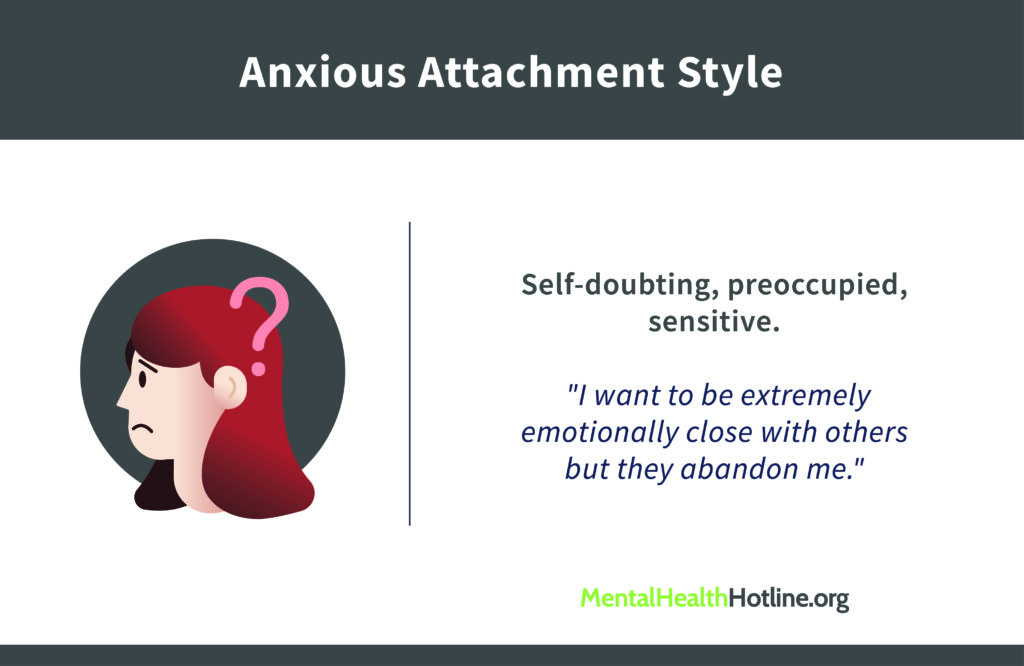
During the experiment, an anxiously attached child wouldn’t explore toys that were too far from their mother and would cling to her when the stranger came in. The child would cry when left alone with the stranger and get angry at their mother when she returned. While they’d still desire close contact with the mom, being held or staying close to the parent didn’t lessen their hurt and anger.
Adults with anxious attachment want their partners to relieve their fears. They tend to fear abandonment and cling to their partners when they feel they’re not getting the appropriate amount of attention or care. Anxiously attached people tend to be mistrustful and deeply worried about their partner’s commitment to the relationship.
3. Avoidant Attachment
Avoidant or dismissive attachment is another type of insecure bonding resulting from neglect or abuse.
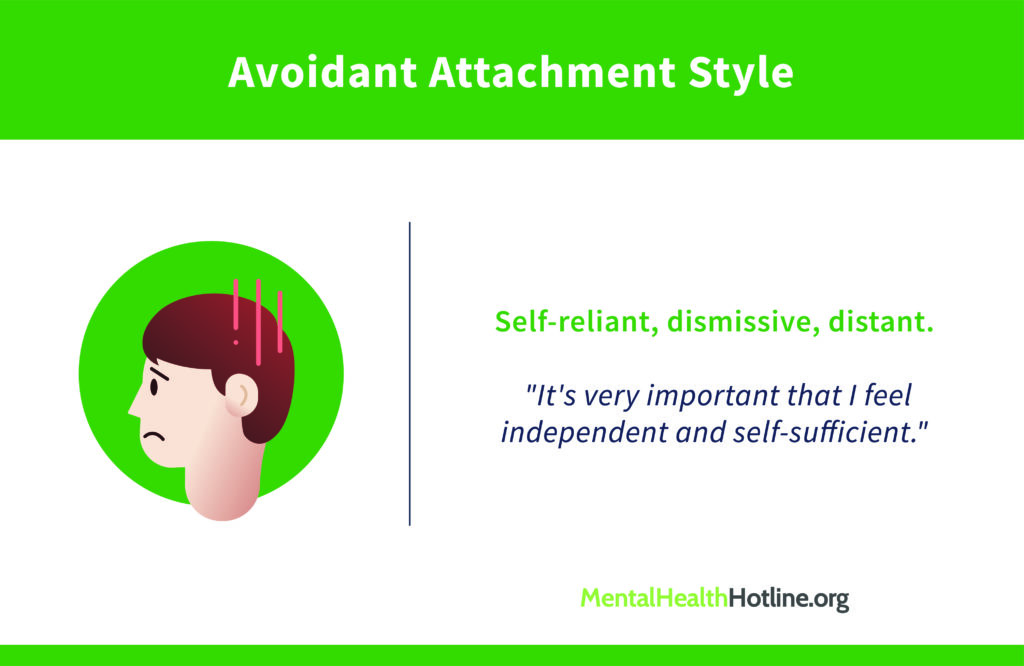
Children with avoidant attachment explored the room but didn’t linger on specific toys. They ignored the stranger, didn’t seem upset when the mother left the room and avoided her when she returned.
Adults with avoidant attachment are highly independent and self-sufficient. They mistrust people’s intentions and loyalty, tending to seek validation from within. They’re restricted, preferring not to express their emotional or physical needs to their partners.
Avoidantly attached people are more comfortable in relationships without deep roots or expectations. Such people tend to pull away if they feel their partner is becoming emotionally reliant on them.
4. Fearful Attachment
Disorganized or fearful attachment was a style identified in the 1990s by a different set of researchers. People with this form of insecure attachment behave inconsistently, displaying both anxious and avoidant attachment traits.
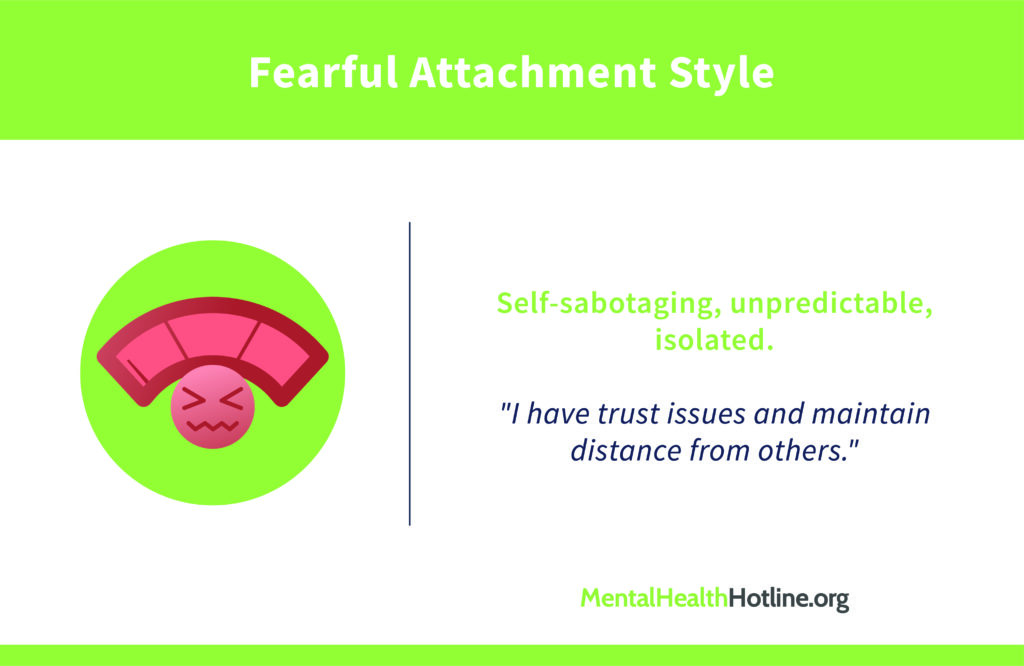
A child with a disorganized attachment style would chaotically explore the room, be suspicious of the stranger and seem conflicted about how to react when their mother left the room. When the mother returned, the child would start going toward them but then pull back and cry or run away.
Adults with this attachment style don’t trust their partners and struggle to feel secure in their relationships. They find it difficult to control their emotions and avoid relationships because of a deep fear of getting hurt.
How to Identify Your Match
So how can you know your attachment style? You can find a free attachment style quiz online on multiple websites. Most sites ask detailed questions to explore how your relationship with primary caregivers formed a basis for your attachment as an adult. An online attachment style test may also assess:
- Your self-perception
- The frequency and length of your relationships
- Your communication patterns
- The level of trust you have for partners
- Your emotional regulation techniques
Discovering your attachment style is a good way of knowing how you present yourself in relationships and the areas you need to improve to become a better partner.
Importance of Knowing Your Relationship Attachment Style
Relationship attachment styles are firmly rooted in infancy and childhood. They reveal the level of security you felt around your parents or guardians and show you the advantages and limitations you learned from the first people who were supposed to love you.
Learning your relationship style can give you insight into your relationship with your parents. If you desire but can’t achieve closeness with them, knowing your attachment style can help you understand how their personalities shaped them and you. It can open up a line of honest dialogue that addresses past wrongs, provides room for gratitude and paves the way for a better future relationship. At the same time, knowing your attachment style can let you see if you grew up in an abusive environment and give you the freedom to close a painful door to your past.
Awareness of your attachment style tells you how you show up in your friendships. You can see whether you do enough for your friends and if they return your efforts. Knowing how to have healthy friendships is key for long-term companionship outside your romantic life.
Understanding the details of your attachment style also provides insight into how you and your romantic partner influence and limit each other. This analysis can even tell you whether to start, continue or end a relationship. It may also lay the foundation for raising a securely attached child.
Learning your attachment style is crucial even if you’re not in a relationship since you have the space to explore your emotional and psychological needs outside anyone’s expectations. It gives you time to develop a secure attachment and helps you set standards for the people you start friendly or romantic relationships with for your long-term well-being.
Don’t Let Your Attachment Style Define You
Like most things, your attachment style isn’t set in stone. It can vary depending on your relationships, whether romantic or not. Some people can help you become more secure, while others can move you toward insecure attachment styles. Moreover, your attachment style can change depending on life events.
Instead of thinking the results of your attachment style quiz are unchanging, use them as a baseline for developing a healthy relationship with yourself and others. Working with a mental health specialist can give you practical, holistic tools to aid you during this process. Contact Mental Health Hotline today to find the support necessary to develop a secure attachment style.
